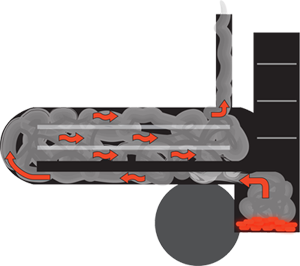GMDGeek
is one Smokin' Farker
Forgive my terminology, I'm still learning the lingo. My search for today is Reverse Flow vs Traditional Pit heat flow (firebox on one end and vent pipes on the opposite).
Obviously either method works, as I've seen and more importantly TASTED some nam nam nammy BBQ from both. What I am more interested in are the Pros and Cons of each.
I know each pit is different and will have its own spirit that has to be tempered. IE hot spots learned, fuel feeding times figured out, stack and vent positions, etc.
As I mentioned in a previous post I've been looking at a Lang or equivalent reverse flow pit. I was asked why and honestly I didn't have a solid answer other than reduced hot spots and if tuned right lower fuel consumption. But that got me to thinking, I need to be better educated.
My brother, my identical twin brother, didn't get this. He said, and I quote, "a pit is a pit, a smoker is a smoker." Mind you he does not smoke bbq - heck he barely knows how to grill a burger. He and his best friend didn't understand when I said GRILLING is NOT SMOKING BBQing; in my book Grilling and BBQ are 2 different things entirely!
Now I'm not going to be a rocket scientist on this (unless I some day learn to weld better and decide that building pits is for me) but I do want to understand the logistics behind it better. So if there are any link/thread already started or if you know of a good explanation I'd love to hear it. Heck I'd love all feedback.
Thanks,
Gerry
Obviously either method works, as I've seen and more importantly TASTED some nam nam nammy BBQ from both. What I am more interested in are the Pros and Cons of each.
I know each pit is different and will have its own spirit that has to be tempered. IE hot spots learned, fuel feeding times figured out, stack and vent positions, etc.
As I mentioned in a previous post I've been looking at a Lang or equivalent reverse flow pit. I was asked why and honestly I didn't have a solid answer other than reduced hot spots and if tuned right lower fuel consumption. But that got me to thinking, I need to be better educated.
My brother, my identical twin brother, didn't get this. He said, and I quote, "a pit is a pit, a smoker is a smoker." Mind you he does not smoke bbq - heck he barely knows how to grill a burger. He and his best friend didn't understand when I said GRILLING is NOT SMOKING BBQing; in my book Grilling and BBQ are 2 different things entirely!
Now I'm not going to be a rocket scientist on this (unless I some day learn to weld better and decide that building pits is for me) but I do want to understand the logistics behind it better. So if there are any link/thread already started or if you know of a good explanation I'd love to hear it. Heck I'd love all feedback.
Thanks,
Gerry


